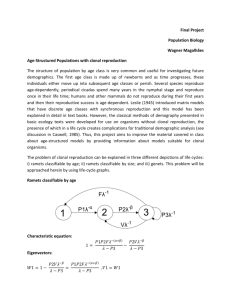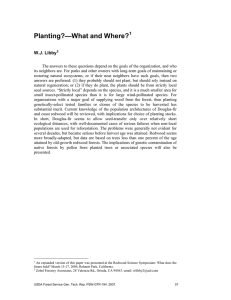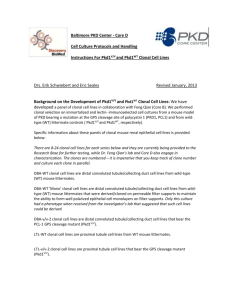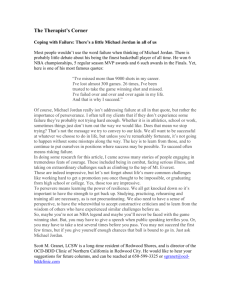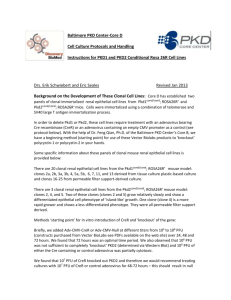Clonal Spread in Second-Growth Stands of Sequoia sempervirens Vladimir Douhovnikoff
advertisement
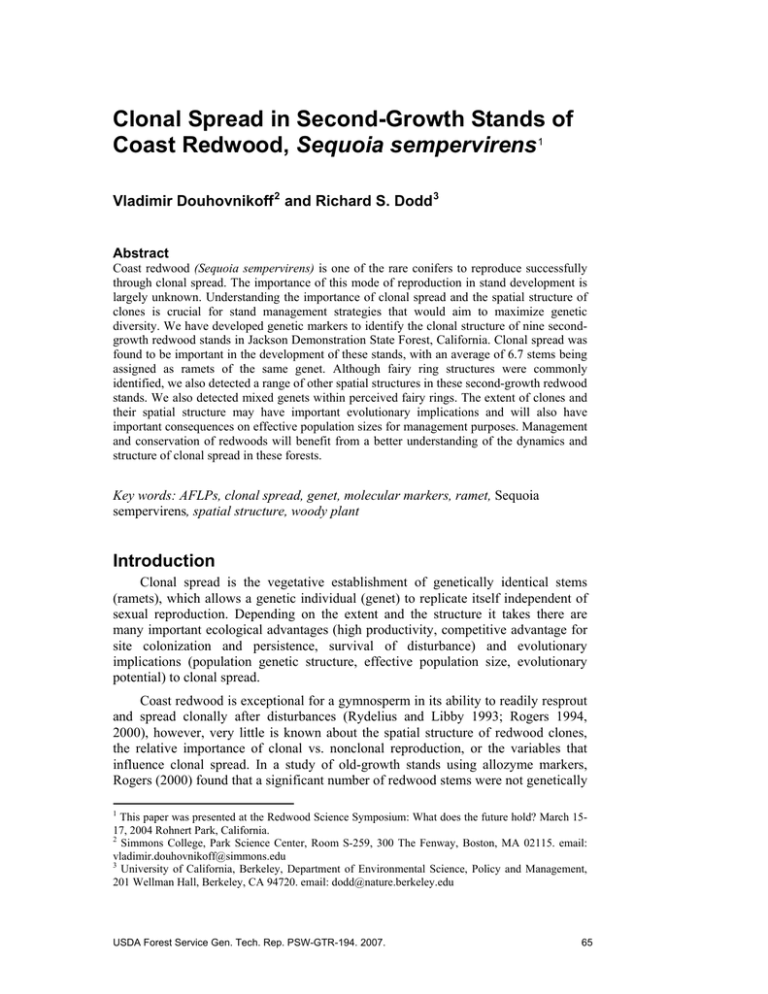
Clonal Spread in Second-Growth Stands of Coast Redwood, Sequoia sempervirens1 Vladimir Douhovnikoff 2 and Richard S. Dodd 3 Abstract Coast redwood (Sequoia sempervirens) is one of the rare conifers to reproduce successfully through clonal spread. The importance of this mode of reproduction in stand development is largely unknown. Understanding the importance of clonal spread and the spatial structure of clones is crucial for stand management strategies that would aim to maximize genetic diversity. We have developed genetic markers to identify the clonal structure of nine secondgrowth redwood stands in Jackson Demonstration State Forest, California. Clonal spread was found to be important in the development of these stands, with an average of 6.7 stems being assigned as ramets of the same genet. Although fairy ring structures were commonly identified, we also detected a range of other spatial structures in these second-growth redwood stands. We also detected mixed genets within perceived fairy rings. The extent of clones and their spatial structure may have important evolutionary implications and will also have important consequences on effective population sizes for management purposes. Management and conservation of redwoods will benefit from a better understanding of the dynamics and structure of clonal spread in these forests. Key words: AFLPs, clonal spread, genet, molecular markers, ramet, Sequoia sempervirens, spatial structure, woody plant Introduction Clonal spread is the vegetative establishment of genetically identical stems (ramets), which allows a genetic individual (genet) to replicate itself independent of sexual reproduction. Depending on the extent and the structure it takes there are many important ecological advantages (high productivity, competitive advantage for site colonization and persistence, survival of disturbance) and evolutionary implications (population genetic structure, effective population size, evolutionary potential) to clonal spread. Coast redwood is exceptional for a gymnosperm in its ability to readily resprout and spread clonally after disturbances (Rydelius and Libby 1993; Rogers 1994, 2000), however, very little is known about the spatial structure of redwood clones, the relative importance of clonal vs. nonclonal reproduction, or the variables that influence clonal spread. In a study of old-growth stands using allozyme markers, Rogers (2000) found that a significant number of redwood stems were not genetically 1 This paper was presented at the Redwood Science Symposium: What does the future hold? March 1517, 2004 Rohnert Park, California. 2 Simmons College, Park Science Center, Room S-259, 300 The Fenway, Boston, MA 02115. email: vladimir.douhovnikoff@simmons.edu 3 University of California, Berkeley, Department of Environmental Science, Policy and Management, 201 Wellman Hall, Berkeley, CA 94720. email: dodd@nature.berkeley.edu USDA Forest Service Gen. Tech. Rep. PSW-GTR-194. 2007. 65 Session 2—Clonal Spread in Coast Redwood—Douhovnikoff and Dodd distinct individuals, but were ramets of larger genets, and thus resulted from cloning and not from reproduction by seed. There are no similar studies of second-growth redwood forests. If we are to properly understand redwood ecology and evolutionary potential, it is essential to further explore the structure, dynamics, and significance of clonal spread in these forests. In the context of management and conservation, for example, this would result in more accurate estimates of minimum viable population size. This is the first major study of clonal spread in redwoods using molecular genetic techniques. In this research our goals were to evaluate the importance of clonal spread in second-growth redwood stands, and to explore the local spatial structure of redwood clones. Materials and Methods The study was conducted in the Jackson Demonstration State Forest (fig. 1) because of its combination of historic intensive management and the availability of mature secondgrowth stands. A total of nine sites were randomly selected (table 1). Sites were widely distributed across the forest, at least 500 m from each other and were pure stands of redwood estimated to have been last cut 50 to 70 years ago. Figure 1—Sample sites of Sequoia sempervirens in the Jackson Demonstration State Forest, north coast of California. Sites are represented by stars and rivers are marked as dotted lines. 66 USDA Forest Service Gen. Tech. Rep. PSW-GTR-194.2007. Session 2—Clonal Spread in Coast Redwood—Douhovnikoff and Dodd Table 1—Data for nine sites across three Sequoia sempervirens site types, in Jackson Demonstration State Forest, north coast of California. Site J1 J2 J3 J4 J5 J6 J7 J8 J9 Totals Stems sampled Genets Clones 37 45 42 42 31 43 38 37 41 356 9 17 21 25 11 26 10 7 22 148 6 6 2 3 3 3 4 4 4 35 SSG (#, percent stem total) 3 (8) 11 (24) 19 (45) 22 (52) 8 (25) 23 (53) 6 (16) 3 (8) 18 (54) 113 (32) PD value Mantel 0.24 0.38 0.50 0.60 0.35 0.60 0.26 0.19 0.54 NA -0.41 -0.42 -0.11 -0.14 -0.45 -0.34 -0.63 -0.59 -0.22 NA On each site, up to 45 adjacent trees over 10 cm in diameter at breast height (dbh) were mapped, tagged, measured for dbh, and sampled for DNA. Sampling included clumped and forked stems that met the size requirement at forking point. With a target of up to 45 trees sampled per site, different stand densities resulted in a variation in total site areas. In a few instances we were unable to collect leaf material due to the extreme height or canopy structure of a tree. Genetic Fingerprinting DNA was extracted according to the Cullings (1992) modification of Doyle & Doyle (1987). Genetic AFLP fingerprints were generated and analyzed for each sampled stem according to the protocols described by Douhovnikoff and others (2004). Clones were then identified using a calibrated threshold methodology (Douhovnikoff and Dodd 2003). Clonal Importance To assess the relative importance of clonal spread on each site, sample percentage distinguishable (PD) values were calculated according to Ellstrand and Roose (1987). PD values are calculated as the number of genets identified, divided by the total number of stems genetically sampled. This metric of clonal diversity measures the percentage of genetically distinct sample trees. The size of genets was measured in two ways. First, the total number of ramets per genet was tabulated to evaluate unit size. Second, aggregate basal areas per genet were calculated to serve as a surrogate for biomass. A limit of 45 sampled trees per site does not necessarily capture all ramets in each genet measured and thus these are minimum genet values. Clone Spatial Structure To test for spatial clustering of clones, we compared the clonal structure based on our threshold approach with the spatial pattern of samples at each of the field sites by means of Mantel tests (Manly 1991; Dodd and others 1998, 2000). For each of the field sites, Mantel R correlations were computed between Euclidean distance matrices calculated from the point coordinates for all sampled individuals and binary matrices, in which pairs of individuals assigned to the same clone were given the value one and all non-clone pairs were given the value zero. Significance of the USDA Forest Service Gen. Tech. Rep. PSW-GTR-194. 2007. 67 Session 2—Clonal Spread in Coast Redwood—Douhovnikoff and Dodd correlations was tested by 1000 random permutations. Mantel R correlation coefficients were Z transformed to produce a parameter with an approximate normal distribution (Sokal and Rohlf 1995) and homogeneity among the Z-transformed Mantel R correlations for all site types was tested using a chi-square distribution. Results Clone Size Out of 356 redwood stems genetically sampled over all nine sites, 113 were identified as single stem genets (SSGs). The remaining 243 were ramets from 35 multistem genets (clones). Clones ranged in size from two to 20 ramets with a mean of 6.7 ramets per clone (SE = 0.75). Ramets per genet are minimum estimates due to the 45 stem sampling limitation. PD values are an inverse measure of the importance of clonal spread on a site. The smaller the value, the greater is the proportion of stems that are replicate ramets of clones. In this study, PD values were as low as 0.19, with an all-site mean of 0.43 (SE = 0.05). On a whole genet basis, mean clone basal area per site 1.36 m² (SE = 0.26) was more than six times greater than mean SSG basal area per site (0.20 m², SE = 0.03). SSGs represented an average of 31 percent (SE = 0.05) of total basal area of all trees sampled (table 2). Clone Structure Generally, clones formed partial “fairy-ring” structures surrounding large stumps. In several cases, however, genetically unique individuals were detected within the fairyring clones (fig. 3d). Also, a wide range of additional structures were detected, including figure eights or chains of multiple overlapping rings as found on site J8 (fig. 2a); concentric rings within larger rings as found on site J7 (fig. 2b); disjunct clones with difficult to characterize patterns (fig. 2c); and distantly disjunct clones with satellite clusters at distances as great as 40 m from the larger ring as found on site J5 (fig. 2d). Mantel correlations between spatial distances among stems on a site and assignment to clones ranged from −0.11 to −0.63. All correlations were negative, indicating a tendency for stems of the same genet to be clustered. 68 USDA Forest Service Gen. Tech. Rep. PSW-GTR-194.2007. Session 2—Clonal Spread in Coast Redwood—Douhovnikoff and Dodd Table 2—Percent of site total basal area represented by each clone and all single stem genets (singles). Site Number of clones Clone 1 Clone 2 Clone 3 Clone 4 Clone 5 Clone 6 Single stem genets (total percent) -------------------------------------------percent---------------------------------------- J1 J2 J3 J4 J5 J6 J7 J8 J9 6 6 2 3 3 3 4 4 4 37 18 62 30 31 39 32 58 13 15 17 4 18 21 14 24 16 12 14 11 na 8 18 2 15 10 10 10 10 na na na na 9 7 8 8 9 na na na na na na na 2 6 na na na na na na na 14 29 34 44 30 45 20 9 57 Figure 2—A selection of four genets that demonstrate the range of Sequoia sempervirens clonal structures found in the Jackson Demonstration State Forest, north coast of California, including (a) chains of overlapping rings on site J8, (b) concentric rings on site J7, (c) disjunct stems on site J1, and (d) distantly disjunct stems on site J5. Shaded circles represent ramets from a single clone. Open circles represent trees not sampled, open triangles (◊) represent single stem genets, crossed circles represent stumps, and dashed circles outline perceived fairy-rings. USDA Forest Service Gen. Tech. Rep. PSW-GTR-194. 2007. 69 Session 2—Clonal Spread in Coast Redwood—Douhovnikoff and Dodd Discussion Clonal Spread and Clone Structure Clonal spread plays an important part in regeneration of redwood stands. We found that on average 59 percent of the stems at a site resulted from clonal spread, with a high of 81 percent and a low of 40 percent. (These are minimum values, and it is possible that 100 percent of the stems are clonal copies of predating stems that no longer exist.) The potential for high numbers of ramets (genetic copies) is commonly overlooked in ecological studies, but our results emphasize the need to consider this mode of regeneration in clonal species such as redwood. Genet sizes are skewed by several SSGs and by a few disproportionately large clones with as many as 20 stems. While the second growth sites we sampled ranged in size from 1000 m² to 3000 m² (measured by the outer drip zone), two to six genets contained the great majority of stems, and distinct genets were only about one sixth of the total number of stems. The skew in ramet number per genet is likely a result of the unevenness of disturbance events that open a window of opportunity for sprout release. For example, a tree that has experienced disturbance (windfall, burned, cut, etc.) may clear an opening and promote sprouting at its base and possibly along its fallen stem resulting in a large numbers of ramets in a particular clone relative to undisturbed genets. Regardless of the cause of this imbalance it is most significant that a few genets monopolize a site as large clones. This has the following interesting ecological and evolutionary implications: (1) Resource use— If all ramets draw upon resources equally, larger clones with more ramets occupy more area and use a greater proportion of site resources. It is still unknown, but if redwood ramets also remain physically integrated, within genet resource sharing is possible. Therefore, large redwood clones not only have a proportionately larger footprint in terms of resource use, but they may also be taking advantage of economies of scale and greater access to resources. (2) Site persistence—Large redwood clones may have important long-term advantages in maintaining site representation and dominance. For example: (i) Clones are genetic replicates of locally successful genotypes giving them a competitive edge over newcomers that are subject to the trial-and-error involved in sexual reproduction. (ii) Little seasonality is associated with sprouting, allowing for a quick response to resource availability. Clones have access to an already established root system, grow much faster than seedlings, and are not susceptible to damping off (Olsen and others 1990). (iii) The risk of mortality for a genet can be spread among its many ramets (Cook 1983, Eriksson and Jerling 1990). (iv) Ramet clumping diversifies stem location and can produce local characteristics that buffer some ramets from damage (Peterson and Jones 1997). (v) With no known biological limit to the number of ramet generations over time that can be produced vegetatively, a successful redwood genotype is locally persistent and theoretically immortal. (3) Greater genetic representation—Large redwood genets have greater genetic representation on a site with more stems, pollen, and seeds—all are important factors driving evolutionary potential. When regeneration by seed is possible, larger clones have a greater likelihood of being a genetic contributor to the cohort. Our results show that redwoods both sprout on a local scale and can spread horizontally through lateral ramet multiplication. For example ramets from the same clone were found to be up to 40 m apart from each other. While in many cases fairy- 70 USDA Forest Service Gen. Tech. Rep. PSW-GTR-194.2007. Session 2—Clonal Spread in Coast Redwood—Douhovnikoff and Dodd rings were a standard unit of clonal structure, on a larger scale clones showed a wide range of shapes. Little is known about how redwood clonal spread occurs beyond local basal sprouting. While fairy-rings, concentric circles, and figure eights or longer chains can be explained by repeated basal sprouting of new ramets, it is still unclear how disjunct structures come about. It is possible that falling trees bury branches that then sprout (Rogers 2000), or that soil disturbance, such as in the use of harvesting equipment, may expose and promote sprouting in roots (Weber 1990, Lavertu and others 1994). An example of this may be the disjunct and somewhat chaotic pattern found on site J1 (fig. 2c). This is an important area for further research. Management Implications The implications of these results can be important and wide reaching in redwood forest management and conservation. Some examples include: i) With significant clonal growth, seedling establishment may be a rare event and, in the short term, may contribute little to site regeneration (Rogers 2000). However, in the long-term, rare seedling recruitment may be sufficient to maintain high levels of genetic diversity (Bond and Midgley 2001). ii) Resprouting and the fact that the genotype is often represented by more than a single stem, can minimize the impact of harvesting on a population’s gene pool. This is contingent on the maintenance of conditions that promote sprouting and adequate sprout survival. iii) Redwood ramets may be biologically and physically integrated and manipulation of a ramet may have an effect on its sister ramets. For example there may be a minimum number of sprouts required to sustain the root system associated with a stump at a particular point in clone development (Olsen 1990). Ramet thinning is known to strongly promote height growth in dominant ramets and is strongly correlated with residual stand density (Oliver and others 1994), and ramet removal can decrease physical stability of remaining ramets (Peterson and Jones 1997). Remarkably little is known of the importance and structure of coast redwood clonal growth at the stand scale. This, combined with earlier technical limitations of accurately measuring clones has resulted in many researchers and forest managers having to use a one stem or one fairy ring per genet assumption in their work. By using molecular methods for identification of clone size, we have shown that such an assumption can result in overestimates of up to 500 percent in genet numbers on a stand scale, and in some cases underestimates diversity within fairy-rings. This work demonstrates that a redwood tree as a genetic organism has a significant horizontal component that is overlooked when the single vertical stem is used as the working unit. In order to better understand stand structure and dynamics and to assess the impact of management practices on redwood stands, this horizontal dimension should be taken into consideration. References Bond, W.J.; Midgley, J.J. 2001. Ecology of sprouting in woody plants: the persistence niche. Trends in Ecology and Evolution 16(1): 45–51. Cook, R.E. 1983. Clonal plant populations. American Scientist 71: 244-253. Cullings, K. 1992. Design and testing of a plant-specific PCR primer for ecological and evolutionary studies. Molecular Ecology 1: 233-240. Dodd, R.S.; Afzal-Rafii, Z.; Bousquet-Mélou, A. 2000. Evolutionary divergence in the panAtlantic mangrove Avicennia germinans. New Phytologist 145: 115-125. USDA Forest Service Gen. Tech. Rep. PSW-GTR-194. 2007. 71 Session 2—Clonal Spread in Coast Redwood—Douhovnikoff and Dodd Dodd, R.S.; Afzal-Rafii, Z.; Power, A.B. 1998. Ecotypic adaptation in Austrocedrus chilensis in cuticular hydrocarbon composition. New Phytologist 138: 699-708. Douhovnikoff, V; Cheng, A.M.; Dodd, R.S. 2004. Incidence, size and spatial structure of clones in second growth stands of coast redwood, Sequoia sempervirens (Cupressaceae). American Journal of Botany 91: 1140-1146. Douhovnikoff, V.; Dodd, R.S. 2003. Intra-clonal variation and a similarity threshold for identification of clones: application to Salix exigua using AFLP molecular markers. Theoretical and Applied Genetics 106: 1307-1315. Doyle, J.J.; Doyle, J.L. 1987. A rapid DNA isolation procedure for small quantities of fresh leaf tissue. Phytochemical Bulletin 19: 11-15. Ellstrand, N.C.; Roose, M.L. 1987. Patterns of genotypic diversity in clonal plant species. American Journal of Botany 74: 123-131. Eriksson, O.; Jerling, J. 1990. Hierarchical selection and risk spreading in clonal plants. In: de Kroon, H.; van Groenendael, J., eds. Clonal growth in plants. The Hague, Netherlands: SPB Academic Publishing; 79-94. Hepting, G.H. 1971. Diseases of forest and shade trees of the United States. Agric. Handb. 386. Washington, DC: U.S. Department of Agriculture; 658 p. Lavertu, D.; Mauffette, Y.; Bergeron, Y. 1994. Effects of stand age and litter removal on the regeneration of Populus tremuloides. Journal of Vegetation Science 5: 561-568. Manly, B.F.J. 1991. Randomization and Monte Carlo methods in biology. London: Chapman & Hall. Oliver, W.W.; Lindquist, J.L.; Strothmann, R.O. 1994. Young-growth redwood stands respond well to various thinning intensities. Western Journal of Applied Forestry 9: 106-112. Olsen, D.F.; Roy, D.F.; Walters, G.A. 1990. Sequoia sempervirens (D. Don) Endl. redwoods. In: Burns, R.M.; Honkala, B.H., eds. Silvics of North America. Agric. Handb. 654. Washington, DC: U.S. Department of Agriculture; 541-551. Peterson, C.J.; Jones, R.H. 1997. Clonality in woody plants: a review and comparison with clonal herbs. In: de Kroon, H.; van Groenendael, J., eds. The ecology and evolution of clonal plants. Leiden, Netherlands: Backhuys Publishers; 263–290. Rogers, D.L. 1994. Spatial patterns of allozyme variation and clonal structure in coast redwoods (Sequoia sempervirens). Berkeley, CA: University of California. Ph.D. dissertation. Rogers, D.L. 2000. Genotypic diversity and clone size in old-growth populations of coast redwood (Sequoia sempervirens). Canadian Journal of Botany 78: 1408-1419. Rydelius, J.A.; Libby, W.L. 1993. Arguments for redwood clonal forestry. In: Ahuja, M.R.; Libby, W.J., eds. Clonal forestry II: conservation and application. Berlin, Germany: Springer; 158-168. Sokal, R.R.; Rohlf, F.J. 1995. Biometry. New York: W. H. Freeman and Co. Weber, M.G. 1990. Response of immature aspen ecosystems to cutting and burning in relation to vernal leaf-flush. Forest Ecology & Management 31: 15-33. 72 USDA Forest Service Gen. Tech. Rep. PSW-GTR-194.2007.

